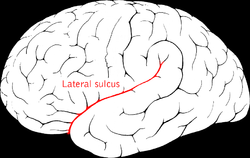| Middle cerebral veins | |
|---|---|
 Outer surface of cerebral hemisphere, showing areas supplied by the cerebral arteries. (Middle cerebral veins not labeled, but region drained is roughly equivalent to pink region.) | |
 Lateral sulcus (Middle cerebral veins not visible, but veins run in lateral sulcus.) | |
| Details | |
| Drains to | Cavernous sinus, basal vein |
| Artery | Middle cerebral artery |
| Identifiers | |
| Latin | venae mediae cerebri (superficialis et profunda) |
| Anatomical terminology | |
The middle cerebral veins - are the superficial and deep veins - that run along the lateral sulcus. The superficial middle cerebral vein is also known as the superficial Sylvian vein, and the deep middle cerebral vein is also known as the deep Sylvian vein. The lateral sulcus or lateral fissure, is also known as the Sylvian fissure.


